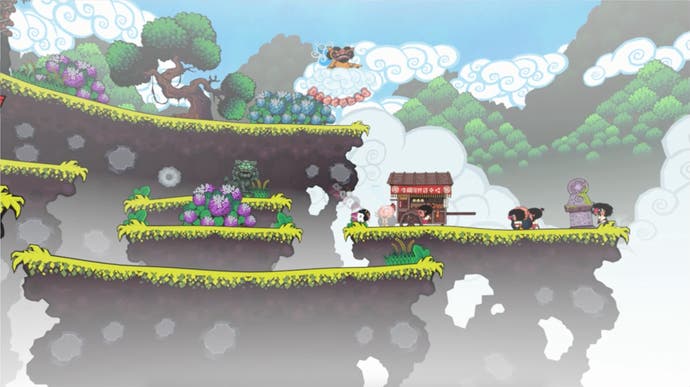Pop-up Pilgrims review - a beautiful VR game lacking in challenge
Paper-thin.
Pop-up Pilgrims provides a nice change of pace and a glimmer of originality for PSVR users bored by the usual churn of glorified shooting galleries. This puzzle-platformer that plays like a Lemmings-lite puts you in the role of a fantastically moustachioed Cloud God tasked with guiding a group of pilgrims to safety across six increasingly dangerous worlds.
Deriving its name from its eye-catching 2D-meets-3D art style, Pop-up Pilgrims really does look like a pop-up book come to life. Each level consists of multiple platforms that the pilgrims must cross safely in order to reach the exit and progress. In VR these platforms pop out at you from the animated backdrop, providing overlapping layers and a unique sense of depth. Each of the 60+ levels are set out in a concave curve from left to right, creating a kind of vertical half-pipe stage in which you sit, dead centre, conducting the action.
Having the levels wrap around like this is wonderful; it's like being encased inside your very own papercraft theatre. While it is possible to turn your gaze 360 degrees and look behind yourself, you'll never need to. Pop-up Pilgrim's sedentary, forward-facing gameplay means at most, there'll be the occasional look left or right to find some out-of-the-way platforms. There's certainly nothing there that'll give you a crick in the neck after some extended game time.

In fact, Pop-up Pilgrims is best played sat back on a sofa, mainly so you can take in each vibrant level in its entirety. There's always the temptation to lean into the world and inspect the cutesy characters close up though, and so you should. The visuals, obviously inspired by traditional Japanese artwork, are bold and bright and full of personality; quite the achievement considering the character animation is rudimentary at best. Also, and this is a great testament to the art style, the assets come across as solid, tangible paper-like objects that you could pick up, play with and perhaps even tear in half.
Guiding your pilgrims to safety is achieved by casting your gaze over individual pilgrims and using the left trigger to make them jump. A little cloud acts as your reticule and once locked onto a target you can change the angle and distance of the pilgrim's jumps by slightly adjusting your head. By doing this you can command the pilgrims to change direction, jump to new platforms, avoid or attack enemies or collect the Golden Octopi, eight of which appear on each level.
The more pilgrim's you have under your command (up to eight at a time) the more you'll need to juggle with them in later levels. Like Lemmings this can sometimes become an exercise in plate spinning, constantly shifting your attention from one to another in order to steer them away from certain death. This is especially true in later levels where one-hit kill hazards are plentiful. The first few worlds ease you into the gameplay so gently however, that losing Pilgrims is often down to user error with the slightly iffy control scheme rather than any environmental dangers.
As you progress, the game keeps track of how many pilgrims you've managed to keep alive. So, lose a few in one level and they'll be deducted from your starting total in the next one, meaning you'll be unable to achieve full marks at the end. Although certain levels do allow you to buy new pilgrims by carting coins to special huts, more often than not you'll need to go back and replay previous levels if you want to get a perfect score on ones that follow.
Each of the six worlds in Pop-up Pilgrims is punctuated by a boss fight, these battles prove a nice distraction from the usual platforming and often rely on you making good use of the skills you've learned along the way. Disappointingly, none of them are particularly challenging, I cleared most boss battles on my first go with minimal loss of life leaving me with an overwhelming sense of "Was that it?!".

It's this lack of challenge that is Pop-up Pilgrim's biggest problem and, sadly, it's not just present in the boss fights. The artwork may be pleasing to look at but when you can snooze your way through even the later levels, it makes the experience utterly forgettable. I was able to breeze through the full game in about 6 hours with only a couple of levels presenting me with any serious challenge. Once you've worked out how the theme for each world affects the gameplay, it's not hard to anticipate any upcoming obstacles. The real difficulty will come for completionists who want to get the gold award for each level, but again this will be more of a test of patience and perseverance rather than actual skill.
Visually, then, Pop-up Pilgrims is a hit, providing something unique to look at in a shooter-obsessed world. Unfortunately the gameplay proves to be paper-thin and veteran VR users will absolutely find the package to be an underwhelming experience. The focus on minimal movement does make Pop-up Pilgrims a great gateway drug for VR beginners though. It provides a taster of the extra dimension that virtual reality offers without the fear of motion sickness that can come with the more extreme titles. Added to this is the fact that it's played via the headset and Dualshock only and you have a good title for entry-level PSVR users who have yet to invest in a pair of Move controllers.

